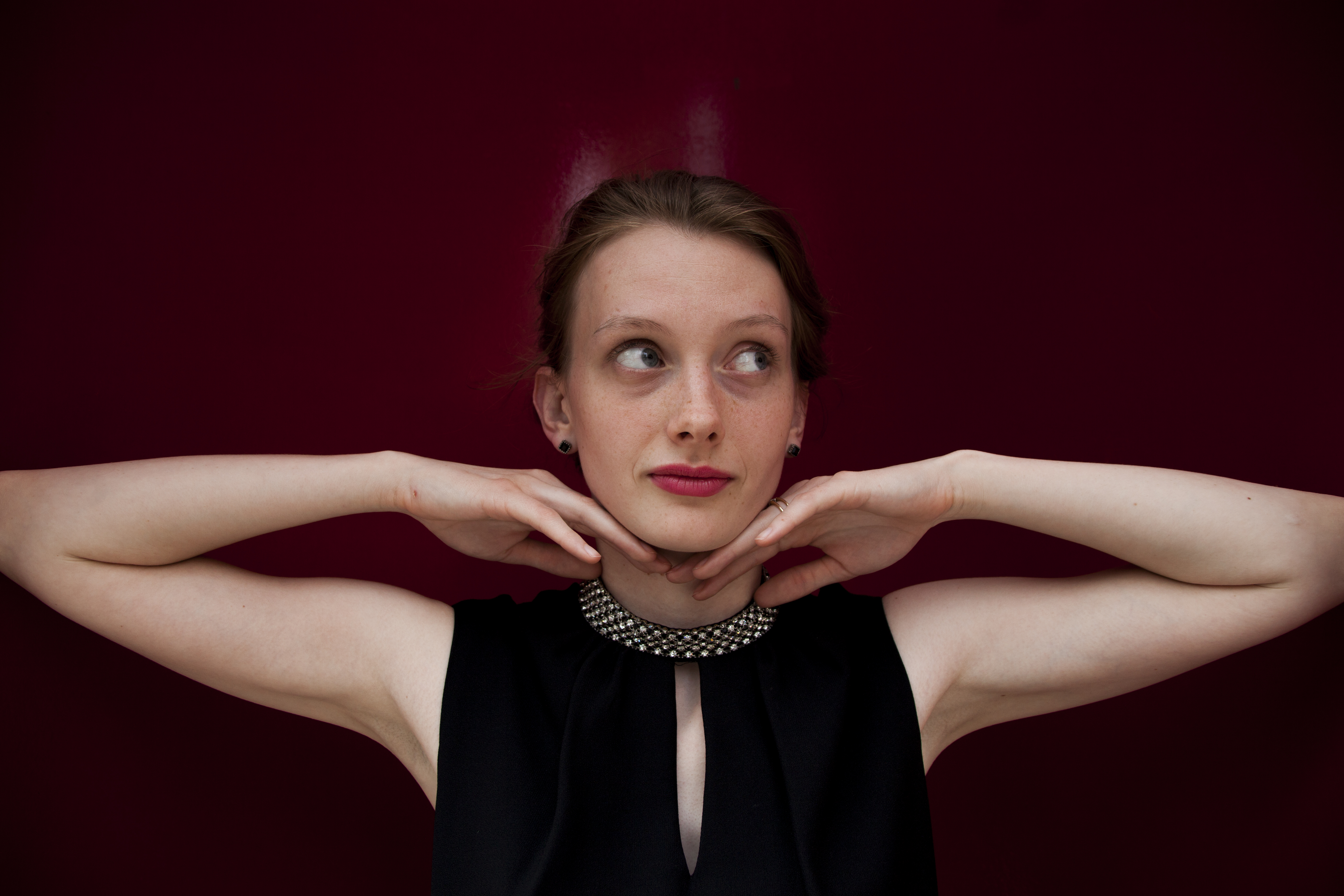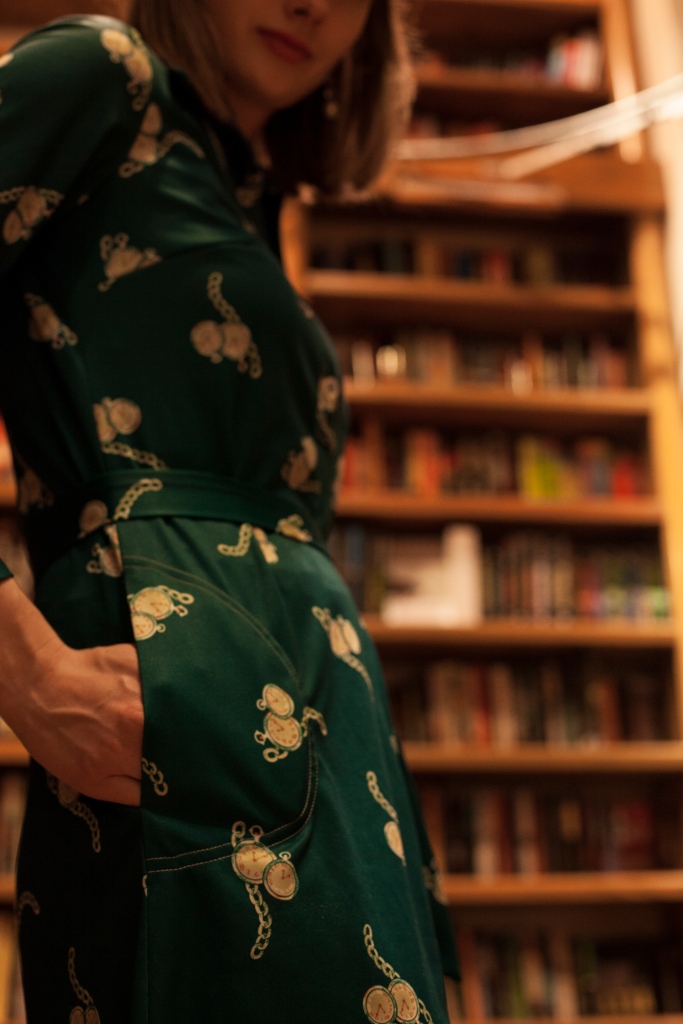
Can you tell that there’s something special about this dress? It’s not a designer label or, as far as I know, a real rarity. (In fact, I recently spotted its twin for sale on Instagram, something that practically never happens for me.) But special is just the way I’d describe it. Why? Just look at those colors. Can you see butterflies like that and not smile? I can’t. This dress is easily one of the most bold in my collection and is one that timelessly transcends the notion of the casual versus formal setting.

The astonishingly bright colors in this dress have aged well: both physically with no visible fading and stylistically. Its playful neon hues are reminiscent not only of the original vibrant late 1960s color palette, but that of the 1990s’ Lisa Frank coloring books and stationary, found in many a young girls’ desk, mine included.
It’s refreshing, too, to see the colors make a resurgence with particular circles of vintage enthusiasts. For many, a vintage passion is a way to recreate (on the daily) a very particular style, often influenced by the victory suits of the 1940s or the full-skirted shirtwaist dresses of the 1950s. Others, however, might appreciate vintage piece by piece for what it adds to their individual style and otherwise modern wardrobes. This is the camp I more often fall into, one that mixes styles and decades, with colors more characteristic of the sixties and a fashion playfulness associated with the seventies and eighties. It truly serves as a reminder that vintage is for everyone, no matter their tastes.
And despite the show that the bright colors put on, black and white might prove to be the most important hues. The crisp white of the dress is the perfect canvas from which those winged beauties might take flight. However, the white background isn’t quite as plain as one might imagine. The dress is actually deeply textured, a floral embossing giving it depth and grounding the flighty piece in something substantial. Along with the contrasting shape and pattern, this is an element that adds sophistication to such a fun number. It’s also a weighty but breathable cotton, which means the dress has infinite possibilities for when-to-wear weather.

The butterflies themselves have a whimsical, hand-painted look to them. Their colors bleed together imperfectly and even escape the faint black outlines of the wings. The sharp black is a striking contrast to the vibrant rainbow of colors, and though the black details are small, an accessory such as a black shoe makes it stand out even more than the other colors.
There are two large white plastic buttons at each cuff and six more down the bodice of the dress which close high on the neck and meet a large, dramatic collar. A simple tie belt, unattached and very similar in nature to the my much-adored pocket watch dress makes an appearance as well.

The union-made bubble gum pink coat is a wool boucle. Its generous length and lightweight drape make for an excellent early spring garment. Double-breasted, its closures are four brass buttons, each imprinted with a regal crest-like image.
A truly unique feeling feature of this piece of outerwear is an triangular-shaped panel attached to the collar near the inside of the left shoulder. The panel snaps to a closure on the other side and acts as a sort of dickey. Fully buttoned, it provides an added layer of warmth to the chest on cool, breezy day. It can also remain tucked inconspicuously under the collar. Horizontal false flaps sit above spacious true pockets on both sides of the coat, making it a continually functional garment.
Each of these pieces is bold in its own right, and together they allow me to re-evaluate the nature of my vintage journey: finding the pretty, the strange, the exciting, and welcoming them into my life with gusto. In the end, I believe the most special thing about the dress is simply that I like it. I think that’s a pretty sweet deal.












 Few garments I own can compete with the absolute glamour of this dress: understated black. A simple shape. An alluring neckline. The most exquisite collar.
Few garments I own can compete with the absolute glamour of this dress: understated black. A simple shape. An alluring neckline. The most exquisite collar. 
 I flew to my haven of vintage, a little space with an antique mirror decked out in hats, and, opposite that, a shelf covered in purses and gloves, a hand mirror, and a swimming cap. In the center stood the two racks: the round one, filled usually with military pieces and heavy hand-knit sweaters, and the one flush against the wall that held an assortment of dresses. I began flipping through the tight space when my hand ran over the smooth black rayon. There is was: my diamond in the rough; the ultimate Little Black Dress.
I flew to my haven of vintage, a little space with an antique mirror decked out in hats, and, opposite that, a shelf covered in purses and gloves, a hand mirror, and a swimming cap. In the center stood the two racks: the round one, filled usually with military pieces and heavy hand-knit sweaters, and the one flush against the wall that held an assortment of dresses. I began flipping through the tight space when my hand ran over the smooth black rayon. There is was: my diamond in the rough; the ultimate Little Black Dress.









 wear it myself.
wear it myself.
 Another interesting note of the dress’s structure is what almost resembles a panel in the center of the bodice, starting around the unique and slightly low collar and trailing to the waist, where one of the embroidered seams is only as wide as the panel.
Another interesting note of the dress’s structure is what almost resembles a panel in the center of the bodice, starting around the unique and slightly low collar and trailing to the waist, where one of the embroidered seams is only as wide as the panel.

























